Heat capacity of water kJ kg deg. Basic thermal quantities
K category: Water supply and heating
Heat transfer fluids and their properties
The heat carriers used in heating systems - water, steam and air are different in their properties and are characterized by specific heat, specific gravity and sanitary and hygienic properties.
The weight of 1 cm3 of a substance in grams is called its specific gravity. The greater the specific heat capacity and specific gravity of the coolant, the more heat must be spent on heating the coolant and the more heat it gives to the room during its cooling.
The specific heat capacity of water is 1 kcal/kg-deg. Thus, each kilogram of water heated, for example, in a boiler to 95 ° C and cooled in a heater to 70 ° C, that is, by 25 ° C, will give 25 kcal of heat to the heated room. Since the volumetric weight of water at an average temperature in the system of 80 ° C is 972 kg / m3, then 1 m3 of water in central heating systems can give off 24,300 kcal / m3 of heat (25X972).
When steam is used as a heat carrier, its latent heat of vaporization is used, which at a steam pressure of 0.2 kgf/cm2 is about 540 kcal per 1 kg of steam.
Latent heat of vaporization is the heat required to turn 1 kg of water into steam. When cooled in heating devices, the steam condenses and gives the room the heat spent on the evaporation of water.
The specific volume of low pressure steam can be taken equal to 1.73 m3/kg, so each cubic meter of steam in the heating system gives off 312 kcal/m3 of heat (540:1.73).
Second important property steam, which has excess pressure, is its desire to expand and reduce its pressure to atmospheric pressure. Due to this property, steam is used in heating technology.
From the sanitary and hygienic side, steam is a less desirable heat carrier than water, since dust, settling on the surface of heating devices with a temperature of about 100 ° C, burns, decomposes and pollutes the air with dry sublimation products. If water passes through the heating devices, then the dust almost does not burn and the air is not polluted.
In air heating systems, air, which serves as a heat carrier, is introduced into the premises at a temperature of 45-70 °C.
Taking the volumetric heat capacity of 1 m3 of air equal to 0.31 kcal! M deg and the temperature of the room to which the air-coolant must be cooled equal to 18 ° C, we get that 1 m3 of air with a temperature of 45 ° C gives off 8.3 kcal / m3 of heat . This shows that air as a coolant has the lowest specific heat capacity.
The advantage of air as a heat carrier lies in its high mobility. Being heated, it acquires a lower specific gravity and, expanding, easily moves up the channels. Having given some of its heat to the room and cooled, it becomes heavier and rushes down through the return channels.
If the heating medium is water or air, the temperature can be adjusted according to the outdoor temperature. Steam makes it possible to regulate the heat transfer of devices only in complex vacuum systems at pressures below atmospheric.
In low-pressure systems, the steam temperature almost does not change and is always above 100 °C.
In connection with the indicated shortcomings, steam can be used as a heat carrier only for heating industrial and municipal buildings.
Comparing heat carriers, it can be noted that the best of them in terms of their thermal, sanitary and hygienic and other properties is water.
Heat transfer fluids and their properties
MECHANICAL PRESSURE UNDER WATER
<<
---
--->>
VISIBILITY in the WATER
Water has special thermophysical properties, which differ significantly from the thermophysical properties of air. So, for example, the thermal conductivity of water is 25 times greater, and the heat capacity is 4 times greater. The specific heat capacity of water C = 1 kcal/kg deg at a temperature of + 15 *C. The heat capacity of water slowly and slightly decreases from 1.0074 to 0.9980 with an increase in temperature from 0 to +40 ° C, and for all other substances, the heat capacity increases with increasing temperature. It also slightly decreases with increasing pressure (with increasing depth). Water can absorb a large amount of heat, heating up relatively little at the same time. About 30% of the Sun's energy is reflected by the atmosphere and goes into space, about 45% is absorbed by the atmosphere, and only about 25% of the solar energy reaches the ocean surface. Part of it (810%) is reflected, and the rest is absorbed. Of all the absorbed solar heat energy, up to 94% is absorbed by the surface layer of water 1 cm thick. Lower layers of water are heated due to natural convection(associated with the inhomogeneity of the medium in temperature and density) and forced convection (mixing by currents, wind waves and tides). As a result of absorption and convection, 60% of solar energy remains in the upper meter layer of water, and more than 80% in the 10-meter layer. At a depth of 100 m, in the absence of intensive mixing, usually no more than 0.5-1% of solar energy penetrates.
The water temperature in the upper layers of reservoirs depends on climatic conditions and can range from -2 to +30 °C. Only 8% of the surface waters of the ocean are warmer than +10 °C, and more than half of the waters are colder than 2.3 °C. Sea water with a salinity of 35%o freezes at a temperature of -1.9 °C. Daily changes in water temperature depend on the nature of the cloudiness and are usually in the range of 0.5-2.0 °C. Basically, these changes concern only a thin surface layer of water, and already at depths of 10-20 m, daily temperature fluctuations are practically zero. The maximum temperature is observed at about 3 pm, the minimum is in the range from 4 to 7 am. Annual temperature fluctuations in the ocean are not as great as on land. If on land they reach 150 ° C, then in the ocean they rarely exceed 38 ° C. The sharpest annual temperature difference is expressed in the middle latitudes, where between August and February it can exceed 10 °C. On the great depths in the middle and northern latitudes, the temperature is constantly maintained in the range from +2 to +4 °С, depending on the salinity of the water.
The cooling effect of water is one of the most important factors limiting a person's stay in the aquatic environment. It significantly reduces the productivity of diving work, and is also the main cause of death of people who find themselves in the water as a result of a shipwreck. The thermal balance of the body of a naked person in water can be maintained by stable level only under the condition that the temperatures of the water and the body are equal, which is impossible in the middle latitudes. Large heat losses in water are explained by its high thermal conductivity and heat capacity. When a naked or underdressed person is immersed in cold water, a certain sequence of symptoms appears. Initially, cold water causes a decrease in skin temperature, which leads to vasoconstriction of the surface of the body. This, in turn, accelerates the decrease in skin temperature, as the influx of heat from the underlying tissues stops. Cold-induced vasoconstriction provides a pronounced thermal resistance, or thermal insulation, in the surface tissues of the body. This resistance depends on the speed of blood flow in the skin. The successive course of these reactions ends when the skin temperature becomes equal to the temperature water. Heat from the heated deeper tissues continues to flow by direct conduction to the surface. When a person is under water without waterproof clothing, the main method of heat transfer is heat conduction, and the mobility of water and the movement of the diver himself contribute to a significant loss of heat. A person heats up more and more layers of water with his body, which leads to a faster loss of heat than in air. With a significant excess of heat loss over heat production in a person in cold water, the body temperature quickly decreases and symptoms of hypothermia develop, passing from functional to pathological.
When using waterproof and heat-protective diver clothing, body heat loss occurs mainly not by conduction, as in direct contact with it, but mainly by heat radiation to the cooling inner surface of the spacesuit (negative thermal radiation), which is 4 times higher than heat transfer by conduction.
From the point of view of reducing heat loss among divers, preference should be given to ventilated equipment. The air cushion of the suit, being a good heat insulator, reduces heat transfer and, at the same water temperature, keeps the body temperature at a higher level than a diving suit or diving suit, in which there is only a slight air gap. In a wetsuit (wetsuit), the head and neck area are cooled, and when breathing in the apparatus, heat loss from the respiratory tract increases. The distal parts of the legs are especially sensitive to cold in divers. In the normal upright position of a diver under water, freezing starts at the toes, which is largely due to water squeezing lower extremities. Subsequently, divers usually complain of freezing hands, back and lower back. The face, chest, abdomen and palms are less sensitive to cold.
Temperature- a measure of the thermal state or degree of heating of the body. The thermal state of the body is characterized by the speed of movement of its molecules or the average internal kinetic energy of the body. The higher the body temperature, the faster the molecules move. The temperature of a body increases or decreases depending on whether the body receives or gives off heat. Bodies having the same temperature are in thermal equilibrium, that is, there is no heat exchange between them.
The unit of temperature is degrees. Two scales are used to measure temperature: centigrade and thermodynamic or absolute (Kelvin). The centigrade scale has two constant points: the melting of ice, which is taken as 0 ° C, and the boiling point of water at normal atmospheric pressure (760 mm Hg), which is taken as 100 ° C. The interval between these points is divided into 100 parts, each of which is equal to 1 °C. Temperatures above 0 °C are indicated with a plus sign (usually not indicated in the text), below 0 °C - with a minus sign.
In the accepted SI Kelvin scale, the reference point is the temperature of absolute zero. Absolute zero is characterized by the complete cessation of the movement of molecules and corresponds to a temperature lying below 0 ° C by 273.16 ° C (rounded 273). The unit of thermodynamic temperature is the kelvin (K).
The temperature in the centigrade scale is denoted by t, and in the absolute scale by T. These temperatures are interconnected by the relation T \u003d t + 273.
Heat(amount of heat) - a characteristic of the heat transfer process, determined by the amount of energy that the body receives (gives off) in the process of heat transfer. In SI, heat is measured in joules (J). Until now, an off-system unit is used - a calorie, which corresponds to 4.187 J. In practice, with some assumption, the amount of heat required to heat 1 g of water by 1 ° C at atmospheric pressure is taken as a calorie.
The transformation of heat into work and work into heat occurs in the same strictly constant ratio, corresponding to the thermal equivalent, work A or the mechanical equivalent of heat E \u003d 1 / A. The values of these equivalents (rounded): A \u003d 1/427 kcal / (kgf m); E= 427 kgf m/kcal.
Specific heat- the amount of heat that needs to be reported to 1 kg or 1 m3 of a substance in order to raise its temperature by 1 ° C. For gases and vapors, a distinction is made between specific heat capacity at constant pressure cv and specific heat capacity at constant volume su. Depending on what is taken as a unit of a substance, heat capacity is distinguished: mass, kcal / (kg ° C); molar, kcal/(kmol °C); volumetric, kcal/(m3 °C). The specific mass heat capacity of water, with sufficient accuracy for practical calculations, is taken equal to 1 kcal/(kg °C).
The specific heat capacity of superheated water vapor depends on the temperature and pressure at which heating occurs, and the mixture of non-condensable gases, in addition, depends on its composition. At 100 °C, the volumetric specific heat capacity is, kcal/(m3 °C): water vapor 0.36; air 0.31; carbon dioxide (carbon dioxide) 0.41.
The amount of heat Q that must be reported to the body (for example, water heated in a boiler) to increase its temperature from t 1 to t 2 is equal to the product of the body mass m, his specific heat c, the difference between the final t 2 and initial t 1 body temperature:
Q= mc(t 2 - t 1).
Enthalpy- parameter of the state of the working fluid (water, gas or: steam), characterizing the sum of its internal energy and potential energy of pressure (the product of pressure and volume). The change in enthalpy is determined by the initial and final state of the working fluid.
Boiling temperature- the temperature at which a substance passes from a liquid state to a vaporous (gaseous) state, not only from the surface (as during evaporation), but throughout the volume.
Specific latent heat of vaporization- the heat required to convert 1 kg of liquid, preheated to the boiling point, into dry saturated steam.
Latent heat of condensation is the heat released during the condensation of steam. It is equal in value to the latent heat of vaporization.
Length and distance Mass Measures of volume of bulk products and foodstuffs Area Volume and units of measurement in recipes Temperature Pressure, mechanical stress, Young's modulus Energy and work Power Force Time Linear velocity Flat angle Thermal efficiency and fuel efficiency Numbers Units of measurement of the amount of information Exchange rates Dimensions women's clothing and footwear Dimensions of men's clothing and footwear Angular velocity and rotation frequency Acceleration Angular acceleration Density Specific volume Moment of inertia Moment of force Torque Specific heat of combustion (by mass) Energy density and specific heat fuel combustion (by volume) Temperature difference Coefficient of thermal expansion Thermal resistance Thermal conductivity Specific heat capacity Energy exposure, power thermal radiation Density heat flow Heat transfer coefficient Volume flow Mass flow Molar flow Mass flow density Molar concentration Mass concentration in solution Dynamic (absolute) viscosity Kinematic viscosity Surface tension Vapor permeability Vapor permeability, vapor transfer rate Sound level Microphone sensitivity Sound pressure level (SPL) Brightness Luminous intensity Illuminance Frequency and wavelength Diopter power and focal length Diopter power and lens magnification (×) Electric charge Linear charge density Surface charge density Bulk charge density Electric current Linear current density Surface current density Electric field strength Electrostatic potential and voltage Electrical resistance Resistivity electrical resistance electrical conductivity electrical conductivity electrical capacitance inductance American wire gauge Levels in dBm (dBm or dBmW), dBV (dBV), watts and other units Magnetomotive force Magnetic field strength Magnetic flux Magnetic induction Absorbed dose rate of ionizing radiation Radioactivity. Radioactive decay Radiation. Exposure dose Radiation. Absorbed dose Decimal prefixes Data communication Typography and imaging Timber volume units Calculation of molar mass Periodic system chemical elements D. I. Mendeleev
1 kilocalorie (IT) per kg per °C [kcal(M)/(kg °C)] = 1.00066921606327 kilocalorie (th) per kg per Kelvin [kcal(T)/(kg K)]
Initial value
Converted value
joule per kilogram per kelvin joule per kilogram per °C joule per gram per °C kilojoule per kilogram per kelvin kilojoule per kilogram per °C calorie (IT) per gram per °C calorie (IT) per gram per °F calorie ( thr.) per gram per °C kilocalorie (th.) per kg per °C cal. (th.) per kg per °C kilocalorie (th.) per kg per kelvin kilocalorie (th.) per kg per kelvin kilogram per kelvin pound-force foot per pound per °Rankine BTU (th) per pound per °F BTU (th) per pound per °F BTU (th) per pound per °Rankine BTU (th) per pound per °Rankine BTU (IT) per pound per °C centigrade warm units per pound per °C
More about specific heat capacity
General information
Molecules move under the influence of heat - this movement is called molecular diffusion. The higher the temperature of a substance, the faster the molecules move and the more intense diffusion occurs. The movement of molecules is affected not only by temperature, but also by pressure, the viscosity of a substance and its concentration, diffusion resistance, the distance that molecules travel during their movements, and their mass. For example, if we compare how the diffusion process occurs in water and in honey, when all other variables, except for viscosity, are equal, then it is obvious that the molecules in water move and diffuse faster than in honey, since honey has a higher viscosity.
Molecules need energy to move, and the faster they move, the more energy they need. Heat is one of the types of energy used in this case. That is, if a certain temperature is maintained in a substance, then the molecules will move, and if the temperature is increased, then the movement will accelerate. Energy in the form of heat is obtained by burning fuels such as natural gas, coal, or wood. If several substances are heated using the same amount of energy, then some substances are likely to heat up faster than others due to more intense diffusion. Heat capacity and specific heat capacity describe just these properties of substances.
Specific heat determines how much energy (that is, heat) is required to change the temperature of a body or substance of a certain mass by a certain amount. This property is different from heat capacity, which determines the amount of energy required to change the temperature of an entire body or substance to a certain temperature. Heat capacity calculations, unlike specific heat capacity, do not take into account mass. Heat capacity and specific heat capacity are calculated only for substances and bodies in a stable state of aggregation, for example, for solids. This article discusses both of these concepts, as they are interrelated.
Heat capacity and specific heat capacity of materials and substances
Metals
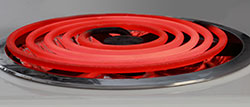
Metals have a very strong molecular structure, since the distance between molecules in metals and others solids much less than in liquids and gases. Due to this, the molecules can only move over very small distances, and, accordingly, in order to make them move at a higher speed, much less energy is needed than for the molecules of liquids and gases. Due to this property, their specific heat capacity is low. This means that it is very easy to raise the temperature of the metal.
Water

On the other hand, water has a very high specific heat capacity, even compared to other liquids, so it takes much more energy to heat one unit mass of water by one degree, compared to substances whose specific heat capacity is lower. Water has a high heat capacity due to the strong bonds between the hydrogen atoms in the water molecule.
Water is one of the main components of all living organisms and plants on Earth, therefore its specific heat capacity plays an important role for life on our planet. Due to the high specific heat capacity of water, the temperature of the fluid in plants and the temperature of the cavity fluid in the body of animals change little even on very cold or very hot days.
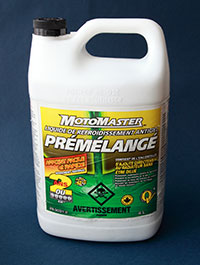
Water provides a system for maintaining the thermal regime both in animals and plants, and on the surface of the Earth as a whole. A huge part of our planet is covered with water, so it is water that plays a big role in regulating weather and climate. Even with a large amount of heat coming from the impact of solar radiation on the Earth's surface, the temperature of the water in the oceans, seas and other bodies of water increases gradually, and the ambient temperature also changes slowly. On the other hand, the effect on temperature of the intensity of heat from solar radiation is large on planets where there are no large surfaces covered with water, such as the Earth, or in regions of the Earth where water is scarce. This is especially noticeable when looking at the difference between day and night temperatures. So, for example, near the ocean, the difference between day and night temperatures is small, but in the desert it is huge.
The high heat capacity of water also means that water not only heats up slowly, but also cools slowly. Due to this property, water is often used as a refrigerant, that is, as a coolant. In addition, the use of water is beneficial due to its low price. In countries with cold climates hot water circulates in pipes for heating. Mixed with ethylene glycol, it is used in car radiators to cool the engine. Such liquids are called antifreeze. The heat capacity of ethylene glycol is lower than the heat capacity of water, so the heat capacity of such a mixture is also lower, which means that the efficiency of a cooling system with antifreeze is also lower than systems with water. But this has to be put up with, since ethylene glycol does not allow water to freeze in winter and damage the channels of the car's cooling system. More ethylene glycol is added to coolants designed for colder climates.
Heat capacity in everyday life
Other things being equal, the heat capacity of materials determines how quickly they heat up. The higher the heat capacity, the more energy is needed to heat this material. That is, if two materials with different heat capacities are heated with the same amount of heat and under the same conditions, then a substance with a lower heat capacity will heat up faster. Materials with high heat capacity, on the contrary, heat up and give off heat back to environment slower.
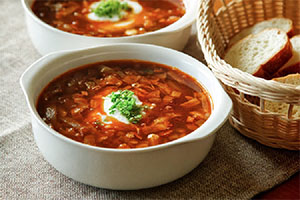
Kitchen utensils and utensils
Most often, we choose materials for dishes and kitchen utensils based on their heat capacity. This mainly applies to items that are in direct contact with heat, such as pots, plates, baking dishes, and other similar utensils. For example, for pots and pans, it is better to use materials with a low heat capacity, such as metals. This helps the heat to transfer more easily and quickly from the heater through the pot to the food and speeds up the cooking process.
On the other hand, since materials with a high heat capacity retain heat for a long time, they are good to use for insulation, that is, when it is necessary to keep the heat of the products and prevent it from escaping into the environment or, conversely, to prevent the heat of the room from heating the chilled products. Most often, such materials are used for plates and cups in which hot or, conversely, very cold food and drinks are served. They help not only to keep the temperature of the product, but also prevent people from getting burned. Ceramic and expanded polystyrene cookware are good examples of the use of such materials.

Heat insulating food
Depending on a number of factors, such as the content of water and fat in products, their heat capacity and specific heat capacity can be different. In cooking, knowledge of the heat capacity of foods makes it possible to use some foods for insulation. If you cover other food with insulating products, they will help this food to keep warm longer under them. If the dishes under these heat-insulating products have a high heat capacity, then they slowly release heat into the environment anyway. After they warm up well, they lose heat and water even more slowly thanks to the insulating products on top. Therefore, they stay hot longer.
An example of a thermal insulating product is cheese, especially on pizza and other similar dishes. Until it melts, it allows water vapor to pass through, which allows the food underneath to cool quickly, as the water it contains evaporates and in doing so cools the food it contains. The melted cheese covers the surface of the dish and insulates the food underneath. Often under the cheese are foods with a high water content, such as sauces and vegetables. Because of this, they have a high heat capacity and keep warm for a long time, especially because they are under melted cheese, which does not release water vapor to the outside. That's why pizza out of the oven is so hot that you can easily burn yourself with sauce or vegetables, even when the dough around the edges has cooled down. The surface of the pizza under the cheese does not cool for a long time, which makes it possible to deliver the pizza to your home in a well-insulated thermal bag.
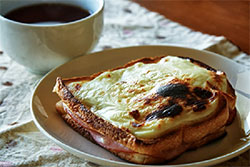
Some recipes use sauces in the same way as cheese to insulate the food underneath. The higher the fat content in the sauce, the better it isolates the products - sauces based on butter or cream are especially good in this case. This is again due to the fact that fat prevents the evaporation of water and, therefore, the removal of the heat required for evaporation.
In cooking, materials that are not suitable for food are also sometimes used for thermal insulation. Cooks in Central America, the Philippines, India, Thailand, Vietnam and many other countries often use banana leaves for this purpose. They can not only be collected in the garden, but also bought in a store or on the market - they are even imported for this purpose in countries where bananas are not grown. Sometimes aluminum foil is used for insulation purposes. Not only does it prevent water from evaporating, but it also helps keep heat inside by preventing heat transfer in the form of radiation. If you wrap the wings and other protruding parts of the bird in foil when baking, the foil will prevent them from overheating and burning.
Cooking food
Foods with a high fat content, such as cheese, have a low heat capacity. They heat up more with less energy than high heat capacity products and reach temperatures high enough for the Maillard reaction to occur. The Maillard reaction is chemical reaction, which occurs between sugars and amino acids and changes the taste and appearance of foods. This reaction is important in some cooking methods, such as baking bread and confectionery from flour, baking products in the oven, as well as for frying. To increase the temperature of the food to the temperature at which this reaction occurs, high-fat foods are used in cooking.
Sugar in cooking

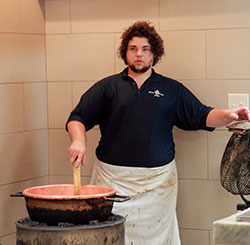
The specific heat capacity of sugar is even lower than that of fat. Since sugar quickly heats up to temperatures higher than the boiling point of water, working with it in the kitchen requires safety precautions, especially when making caramel or sweets. Extreme care must be taken when melting the sugar to avoid spilling it on bare skin, as the temperature of the sugar reaches 175° C (350° F) and the burn from the melted sugar will be very severe. In some cases it is necessary to check the consistency of the sugar, but this should never be done with bare hands if the sugar is heated. Often people forget how quickly and how much sugar can heat up, which is why they get burned. Depending on what the melted sugar is for, its consistency and temperature can be checked using cold water, as described below.
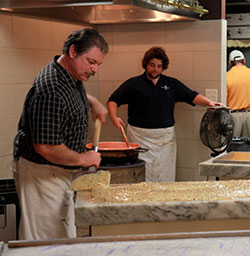
The properties of sugar and sugar syrup change depending on the temperature at which it is cooked. Hot sugar syrup it can be thin, like the thinnest honey, thick, or somewhere between thin and thick. Recipes for sweets, caramels, and sweet sauces usually specify not only the temperature to which the sugar or syrup should be heated, but also the hardness stage of the sugar, such as the "soft ball" stage or the "hard ball" stage. The name of each stage corresponds to the consistency of the sugar. To determine the consistency, the confectioner drops a few drops of syrup into ice water cooling them down. After that, the consistency is checked by touch. So, for example, if the chilled syrup thickens, but does not harden, but remains soft and you can make a ball out of it, then it is considered that the syrup is in the “soft ball” stage. If the shape of the frozen syrup is very difficult, but still can be changed by hand, then it is in the “hard ball” stage. Confectioners often use a food thermometer and also check the consistency of sugar by hand.

food safety
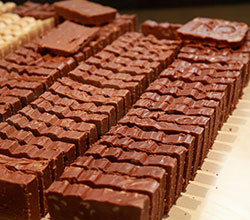
Knowing the heat capacity of foods, you can determine how long they need to be cooled or heated in order to reach a temperature at which they will not spoil and at which bacteria harmful to the body die. For example, to reach a certain temperature, foods with a higher heat capacity take longer to cool or heat than foods with a low heat capacity. That is, the duration of cooking a dish depends on what products are included in it, and also on how quickly water evaporates from it. Evaporation is important because it requires a lot of energy. Often, a food thermometer is used to check the temperature of a dish or the food in it. It is especially convenient to use it during the preparation of fish, meat and poultry.
microwaves
How efficiently food is heated in a microwave oven depends, among other factors, on the specific heat of the food. The microwave radiation generated by the microwave oven's magnetron causes the molecules of water, fat and some other substances to move faster, causing the food to heat up. Fat molecules are easy to make move due to their low heat capacity, and therefore fatty food is heated to more high temperatures than food containing a lot of water. The temperature reached may be so high that it is sufficient for the Maillard reaction. Products with a high water content do not reach such temperatures due to the high heat capacity of water, and therefore the Maillard reaction does not occur in them.
The high temperatures reached by microwave fat can cause some foods, such as bacon, to brown, but these temperatures can be dangerous when using microwave ovens, especially if you do not follow the instructions for using the oven as described in the instruction manual. For example, when reheating or cooking fatty foods in the oven, you should not use plastic utensils, as even microwave utensils are not designed for the temperatures that fat reaches. Also, do not forget that fatty foods are very hot, and eat them carefully so as not to burn yourself.
Specific heat capacity of materials used in everyday life
Do you find it difficult to translate units of measurement from one language to another? Colleagues are ready to help you. Post a question to TCTerms and within a few minutes you will receive an answer.
